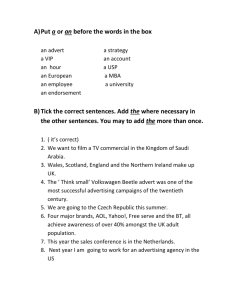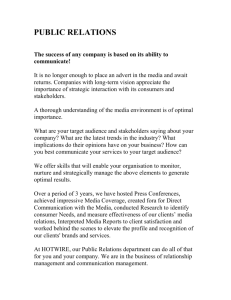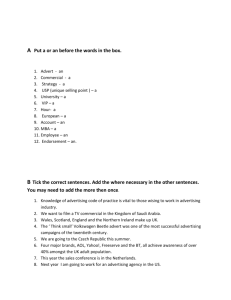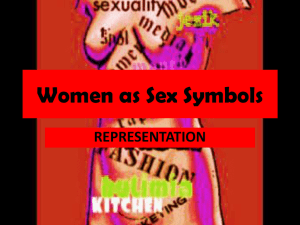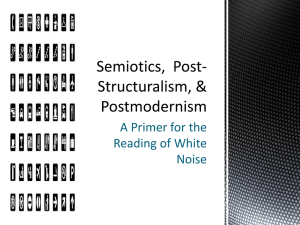Signs&Symbols Toson
advertisement
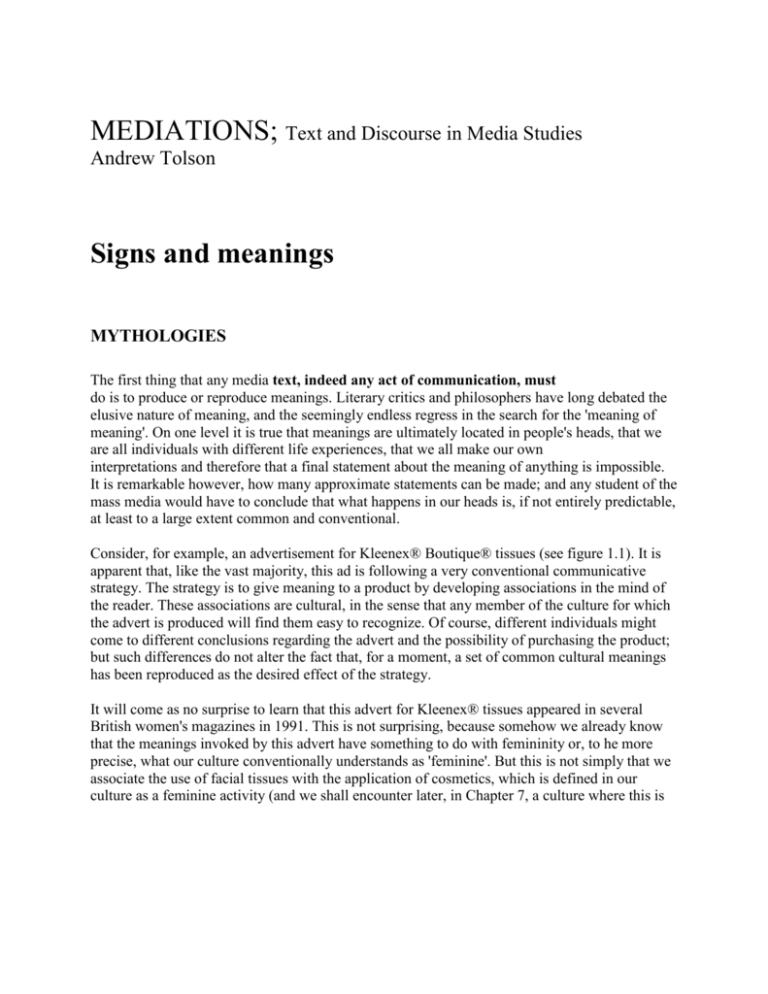
MEDIATIONS; Text and Discourse in Media Studies
Andrew Tolson
Signs and meanings
MYTHOLOGIES
The first thing that any media text, indeed any act of communication, must
do is to produce or reproduce meanings. Literary critics and philosophers have long debated the
elusive nature of meaning, and the seemingly endless regress in the search for the 'meaning of
meaning'. On one level it is true that meanings are ultimately located in people's heads, that we
are all individuals with different life experiences, that we all make our own
interpretations and therefore that a final statement about the meaning of anything is impossible.
It is remarkable however, how many approximate statements can be made; and any student of the
mass media would have to conclude that what happens in our heads is, if not entirely predictable,
at least to a large extent common and conventional.
Consider, for example, an advertisement for Kleenex® Boutique® tissues (see figure 1.1). It is
apparent that, like the vast majority, this ad is following a very conventional communicative
strategy. The strategy is to give meaning to a product by developing associations in the mind of
the reader. These associations are cultural, in the sense that any member of the culture for which
the advert is produced will find them easy to recognize. Of course, different individuals might
come to different conclusions regarding the advert and the possibility of purchasing the product;
but such differences do not alter the fact that, for a moment, a set of common cultural meanings
has been reproduced as the desired effect of the strategy.
It will come as no surprise to learn that this advert for Kleenex® tissues appeared in several
British women's magazines in 1991. This is not surprising, because somehow we already know
that the meanings invoked by this advert have something to do with femininity or, to he more
precise, what our culture conventionally understands as 'feminine'. But this is not simply that we
associate the use of facial tissues with the application of cosmetics, which is defined in our
culture as a feminine activity (and we shall encounter later, in Chapter 7, a culture where this is
not so defined). Our reading of this advert as 'feminine' has much to do with the way the tissues
appear here as flowers (pink in the original), which quite possibly will remind us of a bouquet of
roses. So these are 'flowery tissues', where a manufactured commodity now seems to be
produced organically, and perhaps even with a hint of magic, from an apparently 'natural' source.
To a large extent, we might say, this advert is following a formula. It is a formula which is
repeated over and over again in similar ads for cosmetic products, on television as well as in
magazine advertising. Here, cosmetics are frequently associated with nature, or things natural,
such as the purity of water and the freshness of flowers. Bouquets are ubiquitous in such
advertising and, if the flowers are roses, then a further set of romantic associations is produced.
If, in addition, the name of the product is French (even when the manufacturers are, as here,
American) then other impressions of fashionable sophistication will be added to the mix. Indeed,
whit we ire describing here could be defined as a recipe for cosmetics advertising, except that the
trick is to make it turn out slightly differently each time.
FemininitylNature/Romance - these are examples of what Roland Barthes (1957/1973) defined
as mythologies. By this term he meant, not that the meanings contained in these texts are false
('myth' as opposed to 'truth'), but that they are part of a common cultural currency, a cultural
heritage, into which we are all (formally and informally) socialised. Indeed these common
cultural meanings are not simply false, they are also not simply confined to texts -they are
reproduced by texts, but they also help to define real life situations. It is presumably not
unknown for consumers to be influenced by the mythologies of 'femininity' in these ads and the
association of roses with romance, for example, helps to keep Interfiora busy on St Valentine's
day.
Barthes would have said that the image of the flowery tissues in this advert is acting as a sign.
The advert is actually a combination of signs (flowery tissues, boxes, captions and slogans) and
its meaning is a product of this combination. Each individual sign (such as the tissues) is
comprised by two elements: the signifier, which is the material or physical aspect of the sign
which engages with our senses (in this case a composite photographic image); and the signified
which is the meaning we conventionally associate with this image. In the first instance, the
signified is simply a literal interpretation of the signifier - we recognise that this is a box of
tissues which looks like a bouquet of roses. Barthes referred to this literal interpretation of the
signifier as its denotation. However, as we have just seen, the meaning of this image cannot be
restricted to its literal interpretation. It's not just that we recognise the flowery tissues, all sorts of
other associations are brought into play.
It is most appropriate to think spatially and to imagine that what is going on in our heads as we
look at this image is a passage through different levels of meaning. At the first level, before we
can proceed to any other, we have to be able to supply a literal meaning: to observe, for instance,
that these are indeed tissues which look like roses and not any other species of flower. On that
basis, we may then introduce other levels of meaning which are not literal, but symbolic. These
are the wider cultural associations which we bring to the literal meaning, and which Barthes
called connotations. One of the connotations of roses is romance and one of the connotations of
'Boutique' (or, more generally, 'Frenchness') is cultural sophistication. The advert, in using these
signs, is plugging into these cultural connotations in order to promote this product.
Of course, the written text cannot be ignored in our analysis of the advert. It makes its own
important contributions which add further levels of complexity to our interpretation. In the first
place, we should note that there is a difference between the ways we interpret visual and verbal
signs: for if the visual signs invite, in the first instance, our recognition, the verbal signs
inevitably involve a more complex process of decoding. This is because, whereas the visual sign
can be said to resemble its denotation (this photograph looks like 'flowery tissues'), for the verbal
sign there is no such resemblance, and the reader will need to have access to the language codes
from which the words have been chosen (we will return to some of the implications of this
point). More generally, the language codes are themselves potentially complex, which is why
copy-writers can have such fun manipulating them. Here for instance, the metaphorical use of the
word 'bloom' emphasises the fact that the whole advert is a metaphor ('flowery tissues'). The
company slogan is a verbal paradox which offers a witty afterword. Such uses of language
remind us that advertising is a form of rhetoric, dedicated to the arts of persuasion, and that even
the most conventional ads can be pleasurable and amusing.
So, to recap: signs, which may be verbal or visual (or aural or tactile) are comprised by signifiers
(their material aspect) and signifieds (their meaning, which is a mental construct). The signifieds
are, on one level, literal denotations (what the sign says, what it depicts) and, on another level,
cultural connotations (what the sign symbolises). These are the elementary concepts of
semiology, the study of signs and sign systems (from the Greek word seme) which has
influenced media studies through the work of Roland Barthes, though Barthes himself was
influenced by the Swiss linguist, Ferdinand de Saussure, who first promoted the idea of
semiology in his book Course in General Linguistics (1916/1974).
It is possible, on the basis of our analysis of this relatively straightforward ad, and with these
basic concepts of semiology, to begin to explore more complex permutations of signs and
meanings in contemporary advertising. [here is, however one potential loose end which should
be tied up before ye proceed. We have spoken of romance as a connotation roses, and of cultural
sophistication as a connotation of 'Frenchness', but we (and Barthes) have also used the term
'mythology' to describe the process whereby objects are invested with cultural meanings. What is
the precise relationship between these two concepts, connotation and mythology?
In fact there are two possible definitions, or understandings, of the term 'mythology'. One, which
is current in media studies, is to suggest that the mythologies circulating in our culture provide
individuals with the specific connotations they read into texts. Conversely, advertising agencies
are mobilising these mythologies when they fashion particular images for adverts. Some
common mythologies used in advertising, in addition to nature and romance, are: 'the good old
days' (used particularly to sell food products); 'the happy family' (domestic consumer goods);
and 'fun-loving youth' (soft drinks and so on). In this environmentally conscious age the
'naturalness of nature' sells everything from cosmetics to cars. In short, in this interpretation,
mythologies are like common stores of meaning which can be raided by advertisers and
consumers alike. Clearly it is useful to be able to identify the reproduction of such meaning
systems in media texts.
For Barthes, however, 'mythology' also has an additional dimension. It is not just that media texts
make use of particular meaning systems; it is more that these meaning systems become the
taken-for-granted 'common sense' of the age. A meaning system, like romance, becomes a
mythology when it becomes the 'natural' thing to do to purchase a bouquet of roses on St
Valentine's day. The important point here is naturalisation: it seems 'obvious' that tradition means
quality, or that the 'happy family' is an ideal to which everyone aspires. Mythology is then, in
this definition, the translation of particular meaning systems into lived experiences; and
advertisements, with their perpetual promise of the good life, play a major part in this process.
By fostering a greater critical awareness of the meanings that media texts encourage us to take
for granted, media studies is engaged in a process of 'de-naturalising' our familiar worlds.
PREFERRED READINGS
Some products are, however, easier to advertise than others. In a sense, cosmetics advertising
comes with its mythologies ready made. For other products the available mythologies are
restricted, either by official regulation and codes of practice (which apply for example to
cigarette advertising in Britain) or because the product itself presents intrinsic difficulties. For
instance, the critique of advertisers' approaches to AIDS awareness, where early campaigns
included inappropriate metaphors (like icebergs) and horror film symbolism, was only one
particularly clear example of a general problem. Health promotion generally runs the risk of
offending some, while appearing patronising to others. It may be that the mythological approach,
perfected in consumer advertising, is simply inappropriate to this kind of serious social issue.
Other examples are intriguing, even unintentionally amusing. Consider the advertisement for the
Predictor home pregnancy test kit, which appeared, in 1990, in a variety of women's magazines
across the spectrum from Elle to Bella (see figure 1.2). It features a black and white photograph
of a couple kissing in what appears to be a bistro-type restaurant at closing time. Some chairs
have already been stacked on the tables and the waiters appear to be clearing up. Accentuated in
the monochrome image is the whiteness of the table-cloth and the vase of flowers, close to the
couple, by the right-hand wall. Superimposed is a caption, and a colour (pink) image of the
product. Some verbal text, which we will consider later, underpins the main photograph and is
set alongside the image of the product.
Again, if we now begin to look for connotations and mythology, this advert would seem to point
towards romance (hardly surprising in Be/la, where romance is a major preoccupation
throughout). The signs are these: the kiss, the flowers, the wine glass, the white table-cloth, the
bistro (equalling French style) location. In this example, however, not only the signified (ie. what
we can recognise in the picture), but also the signifier (the fact that a monochrome photograph is
used) point to these conclusions. In this age of glossy colour photography, the black and white
image is anachronistic, perhaps nostalgic - this could be a still from a French film of the 1950s.
The generally romantic image is reinforced by the caption, which is an example of hyperbole
(rhetorical exaggeration): 'For the most fantastic news ever in the history of the world'.
Presumably they're in love, she's pregnant, she's just told him, and they're both overjoyed.
Presumably. Except that (and I am indebted to my students for this interpretation) it is equally
possible that the good news is that she is not pregnant. And this possibility becomes just a little
plausible when we consider who, and for what reason, would be more inclined to place her trust
in Predictor rather than her GP.
Of course, this second interpretation is perverse: it isn't at all what the ad is supposed to mean. In
the Predictor ad, a lot of work has gone into the equation of this product with romance, as the
conventional mythology which surrounds sex and sexuality. A lot of work is necessary perhaps
because, unlike the consumption of perfume or wine, home pregnancy testing is open to other,
less than romantic, possibilities. Indeed, perhaps the accompanying text contains just a hint of
the possibility of worry and anxiety. But the photograph, with its mythology, is in dominance.
Predictor is associated with the positive rather than the negative consequences of romance.
What this advert illustrates, very clearly, is that the meanings constructed in media texts are
generally open to more than one interpretation. The text is, as the semiologist would say,
polysemic. Equally clearly however, the text is also constructed to make one interpretation seem
more obvious, more natural. There is then a preferred reading of this particular text and, through
this reading, there is a preferred association with the product. The preferred reading is the
reading you might make which is preferred by the text (and presumably by the advertiser, though
we are just inferring this from the text analysis) even though other readings are possible.
Sometimes, however, texts contain hints and suggestions of other readings, rather like the guilty
secrets which they are trying, desperately, to repress.
The Predictor ad is, I think, a good example of what Barthes really meant when he wrote about
mythology in popular culture. It is, as I have said, partly about the identification of meaning
systems, like romance, which are reproduced not only in adverts in women's magazines, but also
in the stories and the problem pages. In the latter context, however, we learn, if we didn't already
know, that romance has its limitations, its contradictions and its unintended consequences. In
short, these meaning systems are always open to question, to debate, to critique and to rejection.
There is a feminist reading of many of the adverts which appear in this book which is very
different from that which the adverts themselves prefer. In making their preferences for some
meaning systems rather than others, these adverts are acting as a form of cultural indoctrination,
in the nicest possible way. Which is, again, what Barthes meant by mythology.
INTERTEXUALITY
The Lux advert is interesting because it too contains multiple meanings, but it organises them in
a way which is very different from the previous example. Therc, as see saw, the Predictor ad did
its best to repress alternative readings; here LAIN positively welcomes a reader who can see that
there is more than one thing going on (see figure 1.3). It is a clever and particularly modern type
of advertisement which makes its appeal to the 'knowing' consumer. Ideally (in terms of the
advert's preferred reading) , this knowing consumer not only consumes mythology, but also
knows, quite self-consciously, that this is indeed what she is doing, - and moreover she may
derive a certain pleasure from this knowledge. The knowing consumer is in fact an amateur
semiologist.
Again the Lux advert presents us with a monochrome image and a hyperbolic caption. It is surely
unnecessary to elaborate on the extremely conventional construction of this image, for it relies
entirely on a familiar formula or advertising cosmetics: narcissistic self-indulgence. The model is
alone, in her bathroom/boudoir, revelling in the soapy suds/creams/gels etc, and, in devised
versions, to the accompaniment of light classical music. So this is a mythology of luxury: 'star
treatment for your skin'.
The fun, however, comes with the caption and this transforms the meaning of the ad - in fact it
takes it to a higher level. The caption is, of course, not just hyperbole, it is a quote, (in fact it is a
misquotation, but adverts are not constrained to follow academic standards of referencing). It
reminds the 'knowing consumer' of Humphrey Bogart, in his cups, in Casablanca (1942), in
which the 'bar' he refers to is the night-club of which he is the owner. The caption therefore also
makes a pun on the word 'bar', and the slogan 'star treatment for your skin' takes on an additional
meaning.
Moreover, once we recognise the reference to Casablanca, the image too, begins to look
different. This may be a formulaic boudoir, but it also has some tropical foliage, vaguely visible
cane furniture, slatted blinds and, in its lighting effect, a hint of 1940s film noir. The fact that the
image is black and white begins to make more sense. And what of the model? This is not Irigrid
Bergman herself (though her image has been used in contemporary cosmetic ads) but it is, on
closer inspection, a 1940s hairstyle and what might pass, in the pose and the make-up, for a
certain classical form of glamour. To sum up, the general mythology of luxury has been
relocated, by the caption, and by certain signifieds within the image, in a reference to classical
Hollywood cinema. The fact that this is achieved through a pun might seem to be rather clever.
Of course, to achieve its full effect, the Lux advert relies on the reader's ability to perceive this
cleverness. If the reader did not recognise the quote, the advert would still work, but only in one
dimension, and only on the most conventional level. In this sense, it is much more important to
be able to decode this caption than it is, for example 'Predictor - Right First Time'. For it is
through this caption that the reader then has access to a further, second, lewd of meaning: the
Casablanca connotations, and ultimately the mythology of Hollywood stardom. As a semiologist
would say, this caption (reinforced by some aspects of the photo) constructs for this advert a
certain intertextuality. It is on one level a conventional advert, and on another level it is (like) a
scene from Casablanca. And the crucial thing is that the intertextual reference transforms the
meaning of the advert as a whole.
There are, however, not one, but two levels to this transformation. Certainly the intertextual
references make a conventional advert more interesting. But they also, and this is the important
point, fundamentally transform the relationship between the reader/viewer and the text. We are
back once more to the 'knowing consumer', the amateur semiologist; and the key effect is this: in
understanding the intertextuality and the cleverness of this ad, the 'knowing' reader/viewer is
made aware, precisely, of the ad as a fabrication. Its artificiality is foregrounded; its mythology
is, clearly and transparently, a mass-mediated construction (after all, it comes from Hollywood).
So unlike the potential consumer of Kleerix® Boutique®, the consumer of Lox can have 110
illusions. Glamour is now a kind of game we might play (like the game of spot the quotation),
imagining perhaps that a touch of Hollywood stardom might rub off in the privacy of our own
bathrooms!
I have already suggested that this shift from a straight, to a more playful consumption of
mass-media texts and their mythologies is a significant feature of contemporary mediated
culture. It is certainly a widespread practice in contemporary advertising and it makes these ads
more fun to decode. Quite what it implies in a wider context is, however, difficult to assess. Does
it, for instance, imply that ads have lost some of their power to mystify and that the
'naturalisation' which Barthes thought was so essential to the work of mythology is no longer
such a force? If we get the jokes in ads like that for Lux, does this help to de-naturalise the act of
consumption (actually buying and using this bar of soap)? Or are we perhaps, in our cleverness,
congratulating ourselves on our 'knowingoess', reinforcing our credentials as members of the
mass-mediated world culture? In short, does Lux undermine the myth of Hollywood glamour, or
does it make it for us, as knowing consumers, that much more accessible?
THE 'ARBITRARY NATURE' OF THE SIGN
The intertextual references in the advert for Gordon's gin are to other ads in the same series (see
figure 1.4). It is part of a protracted campaign which follows a formula first developed in
cigarette advertising, where the association of this potentially harmful product with a healthy or
glamorous lifestyle is prevented by the Advertising Standards Authority. This formula, pioneered
in advertising for Benson & Hedges cigarettes, takes one aspect of the packaging for the product,
its colour, and makes this symbolic of the product as a whole. In rhetoric, this strategy is called
metonymy: one aspect of the signifier is taken to represent the entire signified. In advertising for
Gordon's, the colour green represents this particular brand of gin. An amusing advert in the series
uses an entire page of a magazine, coloured in slightly paler green than usual, with the caption:
'A weak Gordon's & Tonic. (Please do not adjust your magazine)'.
Again then, the appeal is to the knowing reader, and this is another instance of the tendency
noted in the previous section. 1 have included this example here, however, in order to introduce
some further general points which are fundamental for media text analysis. One thing which can
be said about all the adverts considered previously is that they are, in a general sense, 'realistic' in
so far as they present us with photographic signifiers which we are invited, in the first instance,
to recognise. 'A man in his birthday suit hiding his modesty' is, however, abstract: the signifier
does not resemble the signified, and perhaps the mythology of the advert is less explicit.
Actually, there is some connection here between signifier and signified. The advert presents us
with a small green rectangle (green = Gordon's) on a flesh coloured page. But there the
resemblance ends for, of course, the flesh-coloured page looks nothing like 'a man in his birthday
suit...' Where the signifier is as abstract as this, it requires a lot of effort to work out what the
signified could possibly be and, if we didn't have the caption, together with our knowledge of
other Gordon's adverts, we would be lost. A similar situation arises when we are at a loss to
understand a foreign language. Where there is little or no resemblance between the signifier and
the signified, it becomes particularly important that we have knowledge of the codes which are
being used. The Gordon's ad presents a kind of challenge to our decoding abilities, whereas it is a
lot easier to make sense out of the Lux advert - even if you've never seen Casablanca.
One important point for media text analysis is that the advertisement for Gordon's gin illustrates
what Ferdinand de Saussure termed the 'arbitrary nature' of the sign. Basing his pioneering
theories on the study of language, de Saussure noted that, in most linguistic signs, the signifier
shows no resemblance whatsoever to the signified, and this is true not only of abstract words like
'meaning' or 'analysis', it is also the case for concrete nouns like 'horse' and 'tree'. The four letters
I have just written could, in principle, signify anything; that we take them to refer to a general
category of plant life is entirely a matter of cultural convention. In this linguistic sign the
signifier does not look like the signified, nor are these two aspects of the sign physically or
materially connected. The linguistic sign is essentially symbolic - and if we were operating
within a different set of codes and conventions the fiveletter signifier 'arbre' would do just as
well.
In this respect, photographic visual signs are something of an exception to the general rule,
precisely because they are so realistic. They are what de Saussure and Barthes termed
'motivated', as opposed to 'arbitrary signs'; and in photographs we do assume a physical
connection between signifier and signified in so far as light, emanating from objects in the real
world, must have entered the camera for the signifier to have been produced. BUT this is not the
case for other types of sign, including other types of visual sign, such as paintings and drawings.
Even realistic representational paintings are more arbitrary than photographs, and the
arbitrariness increases the more abstract they become. Again, entirely abstract visual signs could
mean anything - that they have identifiable meanings is either due to an agreed set of codes and
conventions (such as the abstract, arbitrary, road signs in the Highway Code), or, in the case of
some abstract paintings, a title or caption provided by the artist. Which brings us back to the
Gordon's gin advert once again.
The important thing about signs like this is that they remind us that communication is always a
creative process. Even with a camera there is (o course) some creativity, but with abstract visual
signs, or with language, the point becomes inescapable. Constructing signs, and communicating
through signs, is nut about copying reality; on the contrary it is about signification (a key
concept), producing meanings (signifieds) using more or less arbitrary symbols (signifiers). We
are, however, discussing a conventional and collective process of creativity, because the arbitrary
symbols which we have chosen to signify our experience must, at least potentially, be available
for decoding by somebody else. It makes sense therefore, to say that we have inherited
collectively, within our common culture, a variety of more or less arbitrary systems of
signification (codes), and that it is by making choices and combining elements within these
systems that we are able to communicate meanings.
Dc Saussure makes two further points about the practice of signification, which follow from this
discussion of the arbitrary nature of the sign. The first point is concerned with the general
characteristics of sign systems (and we must remember, again, that human language systems are
taken as the model). The second point is an argument about the meanings which these sign
systems construct. Firstly then, if sign systems are more or less arbitrary, so that their meanings
can only be defined by cultural codes and conventions, de Saussure suggests that these codes
must be founded on a principle of distinguishing one sign from another. Language, he suggests,
is a 'system of differences', where the meaning of each element is defined, not by its natural or
intrinsic properties, but by its relation to other elements in the system. What is being sugested
here is that the signified of tree/arbre is a relative concept - 'tree-ness'- which we can only define
if we can distinguish trees from bushes, hedgerows and so on. Semiology is then, as a matter of
principle, relativistic in its theory of the construction of meaning.
It follows, furthermore, that different sign systems may, in so far as they make these distinctions
in different ways, construct different versions of 'reality'. That is to say, if signs do not have
intrinsic meanings, but on the contrary signify our experiences; and if these signs, in so far as
they are arbitrary, rely on culturally specific codes and conventions, then it follows that the codes
and conventions used by one culture to make sense of its experiences may differ from those used
by another. It then becomes possible to suggest that in their use of different sign systems,
different cultures will construct different 'life-worlds'. We've all heard about the Eskimos with
their eighteen words for different shades of white. More relevant to our present purposes is
Judith Williamson's (1986) essay in which she shows that advertising for Hoover vacuum
cleaners now allows us to distinguish between three different types of dirt! (1) In representing
our experience of the world, in culturally specific forms, sign systems are also shaping and
defining those experiences. Developments in sign systems allow for the construction of new
experiences - for instance certain developments in advertising have constructed the experience of
the knowing consumer.
Ultimately, this argument raises fundamental philosophical questions about the construction of
our experience and what we take to be 'reality'. As de Saussure points out, the idea that signs are
used, as they were first used by Adam, simply to give fixed names to God's creatures, is (in the
general sense of the word) a myth. On the contrary, sign systems produce new signifiers and
signifieds, and they permit the combination and re-combination of signs to construct new
experiences. This brief discussion of advertising supports de Saussure's general point. For even
where the photographic sign is highly motivated and thereby instantly recognisable, it is of
course, at a second level, an entirely arbitrary convention which associates cosmetics with
romance and cultural sophistication. And to the extent that the formula for cosmetics advertising
may develop and change - perhaps through external pressure (such as legislation), or in search of
new ways of appealing to the consumer, all sorts of new meanings are possible. In short, though
our mythologies may at first appear obvious and natural, they are in fact arbitrary and
conventional - as arbitrary as the proposition about that little green rectangle in the ad for
Gordon's gin.
ANCHORAGE
In media texts, signs never appear in isolation or even, like road signs, one at a time. Rather, as
we have already seen, signs appear in combinations of various kinds, such as: flowery tissues,
box, verbal captions etc. Clearly therefore, the meaning of any particular sign is conditioned, or
qualified, by its appearance alongside others. In other contexts, roses might signify 'Englishness',
while the use of the term 'boutique' might refer to a fashionable form of shopping. The specific
way in which the different signs contained in a text have been combined together is known in
semiology as the text's syntagmatic structure. In this chapter we will investigate different kinds
of syntagmatic structure commonly found in media texts, and we will proceed, in Chapter 3, to
consider some potential consequences of these structures for the experience of the reader/viewer.
In the work of de Saussure and Barthes, a distinction is made between the syntagmatic and the
paradigmatic dimensions of texts. The syntagmatic dimension is the way in which the signs
which appear in a text are combined in a particular structure. The paradigmatic dimension
suggests that, at least in theory, these signs will have been chosen from a range of options, and
therefore that their meaning is conditioned, not only by their combination with other signs in the
text, but also, to some extent, by our awareness of other possibilities which have not been used.
In the Kleenex® ad, roses are featured (not daffodils or daisies, which ha ve symbolic
connotations in other contexts). A paradigm is therefore a class o potential signs from which a
selection is made. The chosen signs will then be combined, in more or less predictable ways, to
form a syntagmaric structure.
A brief glance at all the adverts we have previously considered will suggest that, in fact, there is
a fairly standard syntagmatic structure in this type of magazine advert. In each case, the page is
dominated by a visual sign. A verbal sign may or may not be superimposed on this visual sign,
but what always seems to happen is that a further verbal sign (or in the Predictor example, a
quite complex verbal text) appears at the foot of the page. As a structure of meanings, it seems
that the visual sign presents a number of polysemic signifiers and that these may be reinforced by
an equally polysemic verbal sign, which typically contains some form of double meaning -an
ambiguity or a pun. It is the function of the text at the bottom of the page to resolve these
polysemic possibilities and to relate them to the product. In its abstraction, the advert for
Gordon's gin is a very clear example of this strategy: the green rectangle on the flesh-coloured
background means anything or nothing until the caption provides the answer.
This use of the verbal sign to provide a title or caption for a polysemic visual sign was defined,
by Roland Barthes, as anchorage. Anchorage is perhaps the most simple form of textual
structure, where images are combined with words. Anchorage places a verbal sign in a position
of authority with respect to the other signs which appear in the text, insofar as it provides the 'last
word'. There is then, a kind of hierarchy among the various signs combined in texts of this type
some signs carry more weight than others. Some verbal signs make authoritative statements
('Lux. Star treatment for your skin'), whereas others make suggestions or function as quotations.
It is not necessary or inevitable, however, that media texts will be structured in this hierarchical
fashion; nor is it the case that the verbal will always have priority over the visual. Some texts
make authoritative statements, but there are others, structured differently, which give the
reader/viewer more space to speculate on what the meaning of the text might be. There is also a
category of text where the phrase 'making a statement' is perhaps inappropriate, since these texts
are concerned with telling stories, and stories may of course be fictional. In this chapter, \ve will
consider three general types of syntagmatic structure, which I will classify as argument, montage
and narrative. Adverts which are anchored by propositions relating to products (this is most
clearly the case with the Predictor ad) are functioning, in this analysis, as arguments Mid, since
this is perhaps the most basic form of persuasive communication, we will consider it first.
1996 Andrew Tolson
Arnold, London
St. Martin’s Press, NYC
